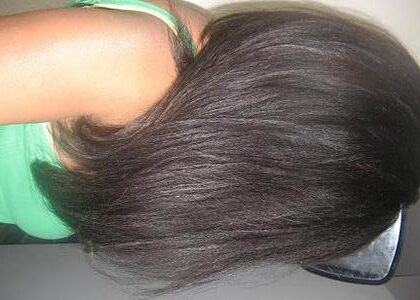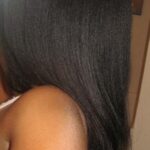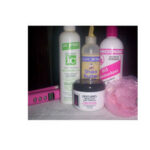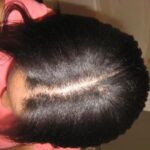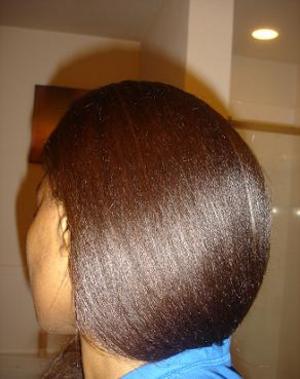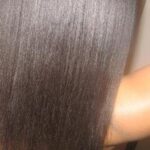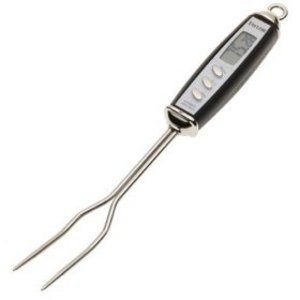Lye or No Lye Relaxers?
This article will focus on the major differences between lye and no-lye relaxers and how to decide which formula is right for you.
General lye and no-lye relaxer information
As a whole, relaxer formulations have pHs that range from 10-14. The higher the pH of the chemical relaxer, the greater the formula’s ability to swell and lift the hair’s cuticle. The more the shaft swells, the more damage the cuticle endures. Relaxer pH also increases as the relaxer formula strength grows from sensitive scalp, to mild, to regular, to super. In general, as the strength of the relaxer formula increases, the pH increases, the degree of cuticle swelling increases, and cuticle lifting increases as well.
There are four basic types of relaxers out on the market today. These four types include:
a.) Lye formulas which can either be base relaxers or “no base” relaxers
b.) and No-Lye formulas which can either be mix or “no mix” relaxer formulas.
Lye relaxers have naturally higher pHs than no-lye relaxers, and this is the reason why these stronger formulas are generally only available to professional stylists.
What is the Chemical Difference?
The differences between lye and no-lye relaxer formulas result from the chemical compounds responsible for the straightening action. For lye relaxers, this compound is sodium hydroxide. In no-lye relaxers, this compound can either be guanidine, lithium, or potassium hydroxide. Though, no-lye relaxers claim to have no traces of lye (or “caustic soda”), this statement is not entirely true as the guanidine, lithium, and potassium hydroxides are in the same metal hydroxide family as sodium hydroxide.
One way to tell whether a relaxer is a lye or no-lye formula deals with the formula’s physical preparation. No lye relaxers, particularly guanidine hydroxide no lyes, will include an activator step—or a separate component to be mixed into the relaxer creme. These are the most popular no-lye formulations on the market. However, not every no-lye relaxer needs to be mixed. Lithium and potassium hydroxide relaxers are no-lye relaxers that are sold as “no mix” formulas.
Lye relaxers will never have to be mixed and will always come alone in a tub ready to apply. The absence of an activator, and the inclusion of the chemical SODIUM HYDROXIDE, lets you know that the fomula is definitely a lye based formula.
No-Lye Relaxers
No lye relaxer formulas are best for self-relaxers or “do-it-yourselfers,” people who have fine hair, children, and those with sensitive scalp conditions. They are also better for those who prefer a straighter relaxed hair turnout.
For years, no lye relaxers have received a bad reputation in the hair industry. There are two major reasons for the poor reception of no-lye relaxers formulations:
a.) While they are generally considered easier on the scalp, they are “harder” on the hair.
b.) Problems arise from the improper application of relaxers in general by amateur do-it-yourselfers.
The Good News about No Lye-Relaxers!
1.) They are easier on the scalp.
Because no lye relaxers are gentler on the scalp, most “sensitive scalp” relaxer formulas tend to be no-lye. These relaxers are best for individuals who prefer milder relaxer formulas and those with sensitive scalp conditions.
2.) Often produce straighter results.
If you are interested in achieving a straighter turnout, no lye relaxers are more likely to straighten the hair more completely than lye relaxers.
3.) No lye relaxers generally bear a lower pH than lye relaxers, and do not lift or swell the hair cuticle as much as lye relaxers to achieve straightening.
4.) No lye relaxers are readily available for general consumer purchase at retail outlets.
They are usually sold in “kits” with everything you will need (activator, stirring stick, base, neutralizer) for your relaxer application.
The Bad News!
1.) No-lye formulations tend to leave mineral deposits behind on the hair shaft.
These mineral deposits can dull the hair and make it less able to absorb much needed moisture. Calcium deposits can make the hair brittle, dry, and prone to breakage. This dryness is perhaps the greatest complaint of individuals who use no-lye relaxers.
**However, it should be mentioned that no-lye relaxing is not the only situation where mineral deposits are exposed to the hair shaft. Hard water contains high levels of minerals that can also leave the hair dull and lusterless. Chelating shampoos are formulated to remove any mineral deposits that are left on the hair by a relaxer or any type of hard water situation.
2.) More breakage of disulfide bonds. **
Because no lye relaxers are able to relax the hair straighter than lye relaxers, they are usually responsible for a greater degree of disulfide bond breakage within the hair shaft. Straighter hair equals more broken cortical bonds. This excessive straightening can contribute to a limp, stick straight, lifeless look to the hair.
3.) No-lye formulas can seem to take longer to actually process the hair. Because many people understand the classic “relaxer tingle” to be their rinsing point, no lye relaxers can give users a false sense of time or security. This apparently lengthier time for processing often encourages people to leave their no lye relaxers in the hair longer than they should or would ever be possible with a lye relaxer. This unfortunately leads to severe overprocessing and breakage.
4.) No lye relaxer mixes are only good for one application.
After no lye relaxers are mixed, they must be used within a day. Any leftover crème must be discarded. The active ingredient in most no-lyes, Guanidine hydroxide, is not stable for long after it has been created. So, the two chemicals that you need to create it (guanidine carbonate and calcium hydroxide) are kept separate until you combine them just before use. Your mixing activates the relaxer by creating the guanidine hydroxide you need. This mixture is good for about 24 hours. This is why no-lye relaxers (particularly guanidine hydroxide) are packaged to be mixed just before use.
What Can I do?
Hair can be healthy and well maintained with a no lye relaxer if the proper precautions are followed.
1.) Protect the hair by covering the already processed hair with either conditioner or oil prior to relaxing. This will reduce bond breakage, and prevent minerals from depositing easily along the hair shaft.
2.) Next, at the wash following the relaxer, it is recommended that you chelate the hair to lift any minerals that may have deposited along the cuticle to reduce dryness. Shampoos like Kenra Clarifying Shampoo, Nexxus Aloe Rid, and Joico Reslove are great chelators to try. Chelating removes the buildup that leads to relaxer dryness so the hair remains soft and receptive of moisture treatments.
3.) Select a quality relaxer brand. Not all no-lye relaxers are created equal. Trusted professional relaxer brands like Mizani and Affirm also make no-lye versions of their lye relaxer formulations available for their customers who prefer them. If you choose the no-lye relaxer route, invest in a trusted, professional relaxer brand that is preferably either Lithium or Potassium hydroxide based to avoid mineral buildup.
Lye Relaxers
Lye relaxers are the preferred formula of the salon industry. Since lye relaxers are by far the stronger of the two chemicals, most lye formulations are not available over the counter. Many stylists argue that lye relaxers are better than no-lye ones, and while there are differences that should be taken into consideration, the honest truth is that any relaxer is only as good as the person applying it and the person maintaining it afterwards.
Lye relaxers are best for individuals with coarser hair types, those who prefer professional applications at salon establishments, and those who desire a lesser degree of straightening.
The Good News about Lye Relaxers!
1.) Lye relaxers are generally easier on the hair.
They do not leave behind dulling deposits on the hair shaft, and therefore do not interfere with the hair’s ability to absorb moisture. They are more likely to leave the hair with a softer, silkier result without further treatments.
2.) Low degree of disulfide bond breakage.
In general, lye relaxers do not straighten the hair as completely as no lye relaxers. This means that the level of disulfide bond breakage from lye relaxers is less than that of no-lye relaxers. Lye relaxers are more likely to leave a level of disulfide bond breakage that still allows the hair to maintain its natural strength and elasticity.
3.) Lye Relaxers process faster than no-lye relaxers. Because they are able to lift the cuticle layers more forcefully and breech layers of base quickly, these relaxers must be applied carefully and quickly to avoid damage to the hair fiber.
4.) More for the money, if you purchase and do them yourself. Lye relaxers are good for multiple applications since the chemicals remain stable for longer periods of time.
The Bad News!
1.) Unfortunately, lye relaxers are very hard on the scalp.
Because the pH of lye relaxers is so high, they are extremely corrosive and damaging to the scalp. The pH of lye relaxers can exceed 13 on 1-14 scale (Halal, 2002). This tendency to “burn” may be part of the reason why lye relaxers tend to underprocess the hair and have difficulty straightening.
2.) Lye relaxers lift and swell the hair cuticle more than no lye relaxers to achieve straightening increasing external damage to the fiber.
Again, the higher pH of lye relaxers makes them the more aggressive chemical. Lye relaxers are able to penetrate the hair shaft faster because of the excessive pH.
3.) Lye Relaxers process faster than no-lye relaxers, which often leads to faster scalp irritation and chemical burning.
4.) In general, lye relaxers do not straighten the hair as completely as no lye relaxers.
Disulfide bond breakage is reduced because the chemical’s aggressiveness tends to put time constraints on the straightening process. However, while the bonds responsible for the curl/coil of the hair are left intact, other critical hair bonds are destroyed on the external layers of the hair.
For better straightening with a lye relaxer, a “base” formula relaxer should be used. These formulas are the strongest lye formulas and require the full coverage of a petroleum base to protect the client.
5.) Expensive and Not readily accessible to do-it-yourselfers.
A professional relaxer application with lye will cost anywhere from $35-$100 depending on your individual circumstances, and for safety, many professional lye formulas are only available to cosmetology professionals.
What can I do?
1.) You can avoid damage from using these relaxers by basing your scalp well prior to relaxing. A thick layer of petroleum base to the scalp and sensitive areas around the neck, ears, and face can prevent scalp damage from lye relaxers. Even if your lye relaxer is “no base,” it is still a good idea to base the entire scalp with a coating of petroleum base. If you visit a stylist for your lye relaxer application, you should base your scalp at home prior to arriving to your appointment to ensure good, even coverage. Stylists are usually short on time, so by doing this you have helped her/him out by getting that part out of the way and have protected yourself in the process.
2.) To counteract the cuticle lifting and swelling damage from lye relaxing, protein conditioning should take place immediately after the relaxer is rinsed and just before a normalizing or neutralizing shampoo is used. This will help rebuild the cuticle and return the scales to their normal orientations. This step can also be done with no-lye relaxer systems.
Conclusion
Both no lye and lye relaxers have downsides. Just because one form is easier on the scalp and one is easier on the hair does not mean that the one that is easier on the scalp can’t damage the scalp, and the one that is easier on the hair can’t damage the hair. You can end up bald and chemically burned with both types. Relaxers by their very nature damage the hair/scalp if they come in contact with it.
The question of which is better ultimately depends on the individual. Neither type is a guarantee of healthy hair, for there are just as many short, broken off heads of hair that swear by both relaxer types. Lye or no-lye, chemicals are chemicals-and if something goes wrong with either one, permanent hair and scalp damage can occur.They both have solvable issues, so really at the end of the day it depends on how you want to mitigate the problems unique to each one.
Relaxer brands both lye and no-lye must be evaluated on their own merits and personal straightening results will always have much to do with the condition of your hair and your smoothing technique.
